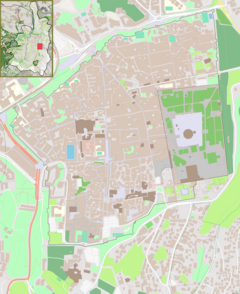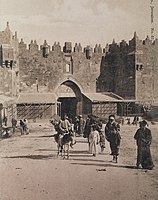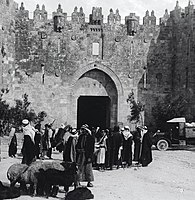Damascus Gate
| Damascus Gate | |
|---|---|
 | |
| Former names | St. Stephen's Gate (Latin:Porta Sancti Stephani;Crusader period) |
| General information | |
| Town or city | Jerusalem |
| Coordinates | 31°46′53.9″N35°13′49.8″E/ 31.781639°N 35.230500°E |
| Completed | 1537 |
TheDamascus Gateis one of the mainGates of the Old City of Jerusalem.[1]It is located in the wall on the city's northwest side and connects to a highway leading out toNablus,which in theHebrew Biblewas calledShechemor Sichem, and from there, in times past, to the capital ofSyria,Damascus;as such, its modern English name is the Damascus Gate, and itsmodern Hebrewname isSha'ar Shkhem(שער שכם), meaningShechem Gate,or in modern termsNablus Gate.[1][2]Of its historic Arabic names,Bāb al-Naṣr(باب النصر) means "gate of victory", and the current one,Bāb al-ʿĀmūd(باب العامود), means "gate of the column".[1]The latter, in use continuously since at least as early as the 10th century, preserves the memory of a Roman column towering over the square behind the gate and dating to the 2nd century AD.[1][3]
History
[edit]In its current form, the gate was built in 1537 under the rule ofSuleiman the Magnificent;[1]however, a gate is known to have been located in the same spot since the Roman period.
Roman and Byzantine periods
[edit]Beneath the current gate, the remains of an earlier gate can be seen, dating back to the time of the Roman EmperorHadrian,[4]who visited the region in 129/130 CE. Directly below the 16th-century gate there is an older gate, dated by most archaeologists to the second century CE.[5]In the square behind this gate stood a Roman victory column topped by a statue of Emperor Hadrian, as depicted on the 6th-centuryMadaba Map.[1]This historical detail is preserved in the current gate's Arabic name, Bab el-Amud, meaning "gate of the column".[1]On the lintel of the 2nd-century gate, which has been made visible by archaeologists beneath today's Ottoman gate, is inscribed the city's Roman name after 130 CE,Aelia Capitolina.[1]
Until the latest excavations (1979–1984),[4]some researchers believed that Hadrian's gate was preceded by one erected byAgrippa I(r. 41–44 CE) as part of the so-calledThird Wall.[6][7]However, recent research seems to prove that the gate does not predate the Roman reconstruction of the city as Aelia Capitolina, during the first half of the second century.[4]
Hadrian's Roman gate was built as a free-standingtriumphal gate,and only sometime towards the end of the 3rd or the very beginning of the 4th century were thereprotective walls built around Jerusalem,connecting to the existing gate.
Early Muslim and Crusader periods
[edit]The Roman gate remained in use during the Early Muslim andCrusaderperiod, but several storerooms were added by the Crusaders outside the gate, so that access to the city became possible only by passing through those rooms.[7]Several phases of construction work on the gate took place during the early 12th century (first CrusaderKingdom of Jerusalem,1099–1187), the earlyAyyubidperiod (1187–1192), and the 13th-century second phase of Crusader rule over Jerusalem.[2]The Crusader barbican consisted mainly in an outer gatehouse opening to the east, and connected to the central portal of the Roman gate by an L-shaped courtyard enclosed by massive walls.[8]The barbican was destroyed twice, in 1219/20 byal-Mu'azzam 'Isawhen he tore down all fortifications in Palestine, and in 1239 byan-Nasir Da'ud.[8]
Names
[edit]The Damascus Gate is the only Jerusalem gate to have preserved its Arabic name,Bab al-Amud('Gate of the Column'), since at least the 10th century.[3]TheCrusaderscalled itSt. Stephen's Gate(in Latin,Porta Sancti Stephani), highlighting its proximity to the site of martyrdom ofSaint Stephen,marked since the time ofEmpress Eudociaby achurch and monasterywhich lies outside the city walls.[9][2]A 1523 account of a visit to Jerusalem by a Jewish traveller fromLeghornuses the nameBâb el 'Amudand notes its proximity to theCave of Zedekiah.[10]
-
The gate from outside the walls, 1904–1908
-
Damascus Gate northern facade, 1920
-
The Damascus Gate from inside the walls, 1945
Description
[edit]The Damascus Gate is flanked by two towers, each equipped withmachicolations.It offers access from the north to the Arabbazaar(souk) in theMuslim Quarter.In contrast to theJaffa Gate,where stairs rise towards the gate, at theDamascusGate the stairs descend towards the gate. Until 1967, acrenellatedturret loomed over the gate, but it was damaged in the fighting that took place in and around the Old City during theSix-Day War.In August 2011, theIsraeliauthorities restored the turret, including itsarrowslit,with the help of photos taken in the early twentieth century when theBritish Empirecontrolled Jerusalem.Eleven anchors fasten the restoredturretto the wall, and four stone slabs combine to form the crenellated top.[11]
Directly below the current, 16th-century gate, an older gate is partially visible, first erected as a triumphal gate for the visit of the Roman emperor Hadrian in 129/130 CE.[5]
Archaeology
[edit]Roman gate and plaza; Crusader gate
[edit]
J.B. Hennessy and C.M. Bennett of theBritish School of Archaeologyexcavated in1964–1966next to Damascus Gate and exposed the facade of the Roman gate's eastern opening, and the Crusader-period outer gate orbarbican.[7]Menachem Magen directed a dig in1979–1984,revealing the entire eastern gate opening, as well as the remains of the towers east and west of the gate and the pavement of the plaza opening up behind (south of) the gateway.[7]The exact extent of the Roman plaza inside the gate is not known, even after the 2013salvage excavationconducted by Zubair Adawi for theIsrael Antiquities Authority(IAA) under a house approximately 40 m south of Damascus Gate. The large paving slabs he unearthed were probably part of the plaza's pavement, but it cannot be ruled out that they were laid out in one of the streets radiating south of it.[12]Excavations have revealed that construction within the Damascus Gate continued under the Byzantine emperor,Justinian I.[13][14]
Culture and literature
[edit]The Damascus Gate is a cultural icon in much of Palestinian literature and culture. It has folkloric and sentimental value to many Palestinians which includes imagery of women sellingbaladiproducts and coffee shops in the square.[citation needed]
Violent confrontations
[edit]Nazmi Jubeh, a professor atBirzeit University,said of Damascus Gate, "[It] has become a symbol for the Palestinian national struggle because of its accessibility to Palestinians and the main connecting point for both worshippers and for markets."[15]Damascus Gate has been an ongoing site of violent confrontations between Palestinians and Israeli soldiers and police.[15]In 2016, there were more than 15 attacks at the gate.The Washington Postpublished an article that year, entitled "Jerusalem's ancient Damascus Gate is at the heart of a modern wave of violence".[16]
In April 2021, Israeli police closed the staired plaza outside the gate, a traditional holiday gathering spot for Palestinians.[17][18]The closure triggered violent night clashes; the barricades were removed after several days.[17][19]
On 18 October 2021, at least 22 Palestinians were wounded and 25 arrested.[20]Since 10 October, when Jerusalem Municipality renewed excavations of graves in the historic MuslimBab al-Asbat Cemetery[21][22]near the Old City, mounting Palestinian anger led to daily arrests.[23]
See also
[edit]References
[edit]- ^abcdefghLaMar C. Berrett (1996).Discovering the World of the Bible(3rd ed.). Cedar Fort. p. 61.ISBN978-0-910523-52-3.
- ^abcAdrian J. Boas (2001).Jerusalem in the time of the crusades: society, landscape, and art in the Holy City under Frankish rule(Illustrated, reprint ed.). Routledge. p. 53.ISBN978-0-415-23000-1.
- ^abMargoliouth, David Samuel(2010).Cairo, Jerusalem & Damascus: Three Chief Cities of the Egyptian Sultans.Walter S. S. Tyrwhitt, illustrator. Cosimo, Inc. p. 329.ISBN978-1-61640-065-1.
- ^abcArchaeological Sites in Israel-Jerusalem:The Northern Gate of Aelia Capitolina,on the website of the Israel Ministry of Foreign Affairs, 29 July 1998, retrieved 7 August 2022.
- ^abGeva, Hillel;Bahat, Dan(1998)."Architectural and Chronological Aspects of the Ancient Damascus Gate Area".Israel Exploration Journal (IEJ.48(3/4). Jerusalem: 225–226.JSTOR27926522.Retrieved7 August2022.
- ^Geva & Bahat (1998), pp. 225-230.
- ^abcdIsrael Antiquities Authority,The Damascus Gate Section,accessed January 2016. Quote: "Some researchers believe the gate was first erected at the time of Agrippa I, in the mid first century CE. If so, then the ancient gate structure was incorporated in course of the Third Wall."
- ^abWightman, Gregory J. (1989).The Damascus Gate, Jerusalem: Excavations by C.-M. Bennett and J.B. Hennessy at the Damascus Gate, Jerusalem, 1964-66.BAR international series, British archaeological reports. Vol. 519. pp. 45, 60.ISBN0860546608.Retrieved7 August2022.Late publication of dig byJohn Basil HennessyandCrystal-Margaret Bennett.
- ^Wilson, C.(1988).Jerusalem, the Holy City (Yerushalayim, ha-ʻIr ha-Ḳedoshah)(in Hebrew). Translated by Eli Schiller. Jerusalem: Ariʼel. p. 45.OCLC19202469.
- ^Simpson, William(1869)."The Royal Caverns or Quarries, Jerusalem".Quarterly Statement(7). London:Palestine Exploration Fund:373–79 [376].Alsohereat archive.org.
- ^Mazori, Dalia (16 August 2011).'הכתר' של שער שכם בי-ם שוחזר מחדש[ "The crown" of Damascus Gate in Jerusalem restored].Nrg Maariv(in Hebrew). Archived fromthe originalon 21 October 2012.Retrieved17 August2011.
עתה, בתום עבודות שימור נרחבות, שוחזר הכתר והמבקרים יכולים ליהנות מיפי השער במלוא הדרו.
- ^'Adawi, Zubair (2021)."Jerusalem, the Old City: remains of a Roman-period pavement near Damascus Gate".Hadashot Arkheologiyot.133.Israel Antiquities Authority: [18–19].Retrieved7 August2022– via Main report, English-language summary (PDF).
- ^Mevorach, David (9 October 2018)."The Emperor and Abbot Build Jerusalem".The Israel Museum,Jerusalem.Retrieved9 Feb2020.
- ^Bahat, Dan;Geva, Hillel (1998). "Architectural and Chronological Aspects of the Ancient Damascus Gate Area".Israel Exploration Journal.48(3/4): 223–235.JSTOR27926522.
- ^abKuttab, Daoud (2016-02-19)."How Damascus Gate became the symbol of the intifada".Al-Monitor.Retrieved2020-08-31.
- ^Booth, William; Eglash, Ruth (2016-02-19)."Jerusalem's ancient Damascus Gate is at the heart of a modern wave of violence".Washington Post.ISSN0190-8286.Retrieved2020-08-31.
- ^ab"'Silence is not an option' in east Jerusalem for Palestinians ".France 24.Agence France-Presse.9 May 2021.Archivedfrom the original on 9 May 2021.Retrieved10 May2021.
- ^Kingsley, Patrick(15 May 2021)."After Years of Quiet, Israeli-Palestinian Conflict Exploded. Why Now?".The New York Times.ISSN0362-4331.Archivedfrom the original on 27 May 2021.Retrieved25 May2021.
- ^Boxerman, Aaron (19 April 2021)."Hundreds of Palestinians clash with police by Jerusalem's Damascus Gate".The Times of Israel.Archivedfrom the original on 22 April 2021.Retrieved12 May2021.
- ^Staff, Al Jazeera."Violent Israeli raids in occupied East Jerusalem wound dozens".www.aljazeera.com.
- ^"Israel demolishes Muslim graves near Al-Aqsa mosque".www.aa.com.tr.
- ^"Palestine: Israel demolishes Muslim graves near Al-Aqsa mosque".The Muslim News.
- ^"Palestinians clash with Israeli police in Jerusalem".The Independent.October 19, 2021.
External links
[edit]- HD Virtual Tour of the Damascus Gate - December 2007Archived2017-11-27 at theWayback Machine
- Holy Land Photos: "Damascus Gate"
- Israel Antiquities Authority
31°46′53.9″N35°13′49.8″E/ 31.781639°N 35.230500°E
- Photos of the Damascus Gateat theManar al-Atharphoto archive





